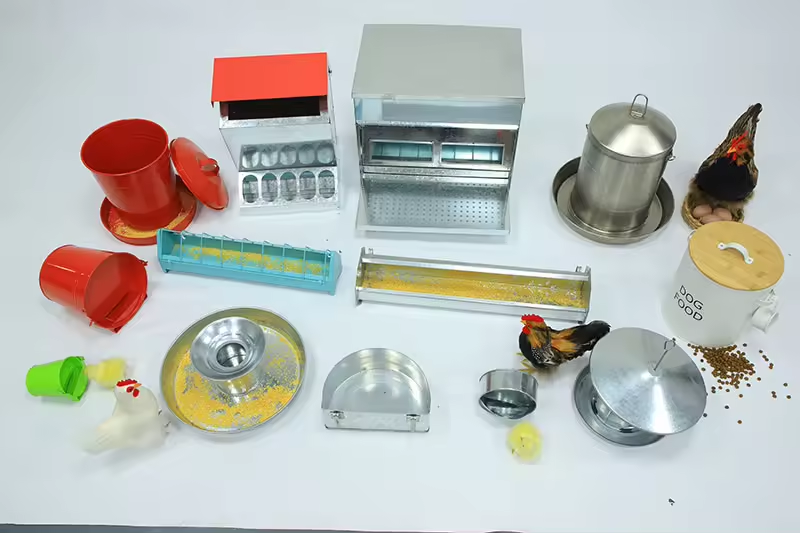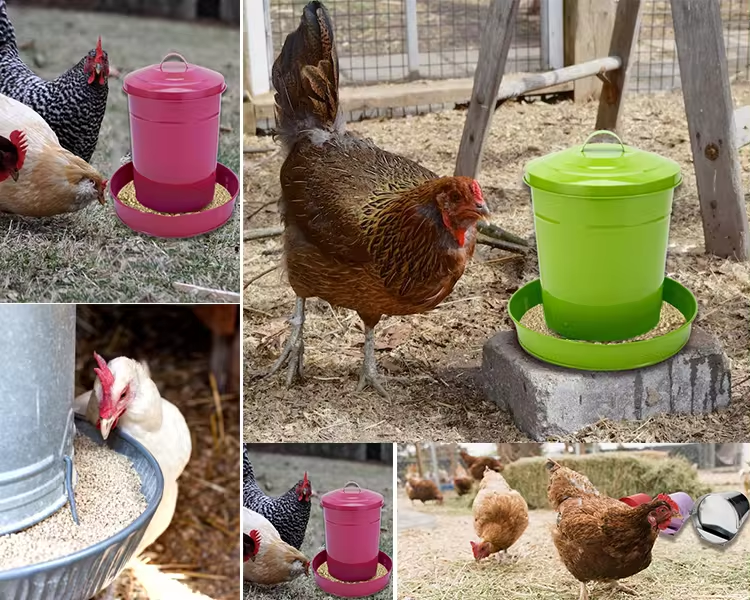
Home & Garden Sundries Supplier
MIF+Garden, Your Bridge To Happy Life- contact us
james.li@mif-garden.com
sales@mif-garden.com
sales001@mif-garden.com - call us anytime
86-18616678980
86-18165659162
86-18923082607

Pubdate: 2024-04-17
Metal chicken feeder is a device or container made of metal material used to feed poultry, specifically chickens.
The main objective of this feeder is to supply the required food for chickens and provide a convenient and efficient means for them to access the feed.

Here are several common types of chicken feeders:
Automatic Feeders: These feeders have automated feeding functions and can release an appropriate amount of feed based on preset time intervals or the needs of the chickens.
They are often equipped with timers or sensors to ensure chickens have access to the right amount of food, avoiding overfeeding or hunger.
Hanging Feeders: Hanging feeders are suspended from supports inside or outside the chicken coop, allowing them to hang freely.
Chickens can access the feed through openings at the bottom, while the design of the feeder reduces waste and contamination.
Ground Feeders: Ground feeders are placed on the ground, allowing chickens to access the feed through surrounding openings.
These types of feeders are commonly used for outdoor feeding, meeting the feeding requirements of chickens.
Linear Feeders: Linear feeders are long and narrow feeders typically used in large-scale chicken houses.
Feed is supplied along the channel of the linear feeder, and chickens can freely access it along the channel.
Circular Feeders: Circular feeders feature central feeding, with feed placed in the center of a circular container. Chickens can feed around the container.
Spiral Feeders: Spiral feeders have spiral-shaped channels, where feed moves downward along the spiral path. Chickens can feed along the spiral channel.
These feeder types cater to different scales and types of chicken farming needs.
Choosing the appropriate feeder helps improve feed utilization, reduce waste, and enhance the health and productivity of chickens.

Here are more details about the materials commonly used for chicken feeders:
Plastic: Plastic feeders are a popular choice due to their lightweight nature, affordability, and ease of cleaning.
They are typically made from durable and food-safe plastics such as high-density polyethylene (HDPE) or polypropylene (PP).
Plastic feeders are resistant to corrosion, which makes them suitable for both indoor and outdoor use.
They are available in various sizes and designs, including gravity-feed or tube-style feeders.
Galvanized Steel: Galvanized steel feeders are highly durable and resistant to rust and corrosion.
They are made from steel coated with a layer of zinc, which provides protection against moisture and extends the feeder's lifespan.
Galvanized steel feeders are known for their sturdiness and ability to withstand harsh weather conditions.
They are commonly used in commercial poultry operations or areas with high wear and tear.
Aluminum: Aluminum feeders are lightweight, sturdy, and resistant to rust and corrosion.
They are easy to handle, making them convenient for moving and cleaning.
Aluminum feeders are commonly used in backyard chicken keeping or smaller-scale poultry operations.
They may not be as strong as galvanized steel feeders but still offer good durability.
Wood: Wooden feeders can be used in certain situations, such as in small backyard flocks or decorative settings.
They are usually made from treated or rot-resistant wood, such as cedar or cypress, to withstand exposure to moisture and extend their lifespan.
Wooden feeders can add a rustic or natural look to the environment.
However, it's important to note that wood can be more challenging to clean and sanitize compared to plastic or metal.
Ceramic or Stoneware: Ceramic or stoneware feeders are less common but can be aesthetically pleasing and durable.
They are often heavy and stable, which makes them difficult for chickens to tip over.
Ceramic or stoneware feeders are typically used in indoor or protected outdoor environments where aesthetics and durability are prioritized.
They may require careful handling to prevent breakage.
When selecting a material for a chicken feeder, consider factors such as durability, ease of cleaning, resistance to corrosion, cost, and the specific needs of your flock.
It's essential to choose materials that are safe for the chickens and can withstand the conditions of the poultry environment.

Chicken feeders offer numerous advantages. Here are some specific benefits:
Convenience and Time-saving: Using chicken feeders significantly saves time and effort in feeding chickens.
Feeders can hold a large quantity of feed, reducing the need for frequent refilling.
This is especially beneficial for large-scale poultry farming operations, as it streamlines the feeding process and minimizes labor requirements.
Feed Control and Waste Reduction: Well-designed feeders allow for precise control over the amount of feed dispensed, ensuring chickens receive optimal nutrition without overeating.
By limiting access to the feed through designated openings, feeders help minimize spillage, prevent contamination, and reduce feed waste.
Hygiene and Cleanliness: Chicken feeders are designed with hygiene in mind.
Many feeders feature removable components or easy-to-clean surfaces, facilitating regular cleaning and maintenance.
By keeping the feed elevated and separate from the ground, feeders help prevent contact with droppings, reducing the risk of disease transmission and maintaining a cleaner environment for the chickens.
Feed Protection and Durability: Feeders provide protection for the feed from various factors.
Feeders made from durable materials, such as galvanized steel or high-density plastic, offer increased resistance to damage caused by pecking, scratching, or harsh weather conditions.
This ensures the feed remains intact and uncontaminated, preserving its nutritional value and reducing feed-related losses.
Feed Distribution and Behavior Regulation: Chicken feeders can influence the distribution of feed within a flock and regulate chicken behavior.
Feeders with multiple access points or partitioned compartments help minimize aggressive feeding behavior and reduce competition among chickens.
This promotes a more even distribution of feed, ensuring all chickens have equal access to nutrition and minimizing stress within the flock.
In summary, the advantages of chicken feeders encompass convenience and time-saving, precise feed control and waste reduction, improved hygiene and cleanliness, feed protection and durability, as well as optimized feed distribution and behavior regulation.
These benefits contribute to efficient and effective poultry management practices, leading to healthier and more productive flocks.
Previous:The Metal Utensil Caddy A Staple in Today's Entertaining Market
Next:Transform Your Scraps to Gold The Magic of Compost Bins for a Greener Life